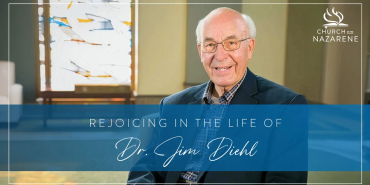New Hope

“How would you feel about the merger of First Church and Trinity?” One rarely knows what to expect when meeting a new district superintendent (DS). I certainly did not expect to hear that question during the very first meeting and meal with our newly arrived DS in the fall of 2012. While the question caught me off guard, my answer was almost immediate: “I think that should have happened about 10 years ago . . . but if I’m being honest, I would like to have a job at the end of the day.” What little I thought I knew about church mergers at that time—that it almost always displaces both current pastors—was about to change.
There isn’t time to recount all that happened between that first meeting and November of 2012—there is much more to the story—but ultimately, both church boards voted unanimously to present the idea of the merger to their respective congregations, and both congregations voted overwhelmingly to merge. By mid-December, the foundation for the merger was laid and a road map and timeline were beginning to take shape.
From the beginning, the concept was simple: 1) merge the two congregations, 2) sell the First Church property, and 3) relocate to the property that Trinity owned.
First Church was situated in a fantastic, mid-town location; however, we were landlocked and had no room to grow. Not only did we not have room for growth, we didn’t have room to meet the city’s off-street parking code. Trinity had almost four acres of land, providing plenty of room to expand as we anticipated growth and increased influence in the community.
As simple as our plan might have sounded, we were wise enough to know that we were facing an uphill endeavor. We would be asking some folks to drive “clear across town.” We knew that renovations were desperately needed to the sanctuary, basement, and foyer of the facility. We would be asking one congregation to walk away from a facility that their blood, sweat, and tears had built. We would be selling a facility that held the sacred memories of child dedications, VBS and Christmas programs, marriage vows, salvation, sanctification, and final farewells to loved ones.
We would be taking 80 years of history from one congregation and 60 years of history from another congregation in trying to merge them into a unified body that would embark upon a new mission of ministry together—this alone is a daunting task.
There is always something of an air of rivalry between churches—even if they get along well. Statistics and reports lead us to compare ourselves to one another. In presenting the idea of a merger, we were asking two churches that had been engaged in a cross-town rivalry to come together and make one new team going forward. There would no longer be the legacy of two churches; rather, we would be blazing a new, united trail and seeking new ways to serve God’s Kingdom, the community, and one another. To this day, we need to be reminded to keep these three in their proper order.
In many ways, merging two congregations can be compared to blending two families. We had to find ways to compromise and come together. Both churches had countless traditions, possessions, and histories that held significant sentimental value but did not have much moral or ethical significance. For example, we had two communion altars, two fully stocked kitchens, two organs, etc. We almost had two of everything!
Both congregations had been through the era of the church that promoted “ownership” to get members to “buy in” and get involved with the church’s mission and ministry. On nearly every item we owned, and on most of the duplicates, we had nameplates giving credit to the person or family that had provided that particular item for the church. We had placards on everything from instruments to hymnals to furniture. Our effort to resolve the dilemma of removing these names from items in both buildings was to create a “memorial tree” where past contributions and future endeavors would be recognized.
Since one building and property were being sold, we made every effort to transfer its legacy and history—it may have been “out of sight,” but we never wanted it to be “out of mind.” Approximately three-quarters of the newly formed congregation was losing the facility they had called home since 1959. We had to ensure that the move to the new facility wasn’t into “marked territory” where shadows of the past would prevent or dissuade our newly blended family from blossoming.
In the process of the transition, we also tried to avoid too much controversy over the ownership of “stuff.” One Sunday morning, it was announced that congregants at either facility could take back any personal or donated items with no questions asked. I was not prepared for the number of disappearances that happened during that time! But this solution did appear to disarm one of the traps that could have hindered the success of the merger.
I tend to see everything with clear distinctions, so my willingness to make decisions and suggest direct courses of action tends to give me plenty of opportunity to offend others. During the merger, I spent extra time trying to work through each decision as carefully as possible. At almost every turn, the leadership sought input from anyone willing to voice their opinion (and we used committees for almost everything). While this meant that everything we did took two or three times longer than we might have liked, it helped immensely to allow for as much input as possible.
We selected our new name after taking suggestions from anyone willing to submit one. Once we had our list of prospective names, we narrowed those using polls. After we narrowed the list down to three choices, I preached a sermon on how the community might approach each name and how it might serve to inform and direct our future efforts to impact the community for God’s glory. Ultimately, a vote between the three final entries resulted in our name—New Hope Church of the Nazarene.
Grace. Patience. Compromise. Perspective. These words guided and informed our every effort during the transition. While I am sure this is not a complete list, several things were key to a good beginning for New Hope:
- Prayerfully seeking God’s direction for every decision.
- Long conversations with leadership as we undertook anything that may have become even remotely controversial.
- A stubborn pastor that would not entertain fighting and bickering over non-essentials.
- Board members and congregants who were willing to seek first God’s Kingdom even when it meant denying the self-identity that each church brought to the merger.
- A kind, faithful, and compassionate God who wanted to breathe new life into a little church on the hill.
If I were to offer a single piece of helpful advice to churches that were considering a merger, it would be to pay careful attention to their histories. I do believe it is necessary for us to remember history, but I fear that too often we allow it to prevent us from moving forward. We look back at “the good old days” and only remember what we want to remember. We look at where we’ve been, and we take pride in our past accomplishments. More often than we’d like to admit, we look back and take credit for what God has done; this is the danger of history and human nature. But I think there is a lesson to be learned whether a church is considering a merger or not—something that may help us keep history in perspective.
We have a chunk of lava rock that sits somewhere in our facility. Usually, it is in the sanctuary and easy to find, but sometimes we move it around when seasonal decorations are in place. We have had this rock for almost 20 years—we even named it! However, it isn’t a “pet” but a reminder. In the same way that Samuel instructed a rock to be placed and named it Ebenezer, our rock serves as a constant reminder that, “up to this point, God has been with us!” (1 Samuel 7:12).
For anyone in our church, the rock is a reminder that God has brought us to this point. We remember the times of the past, times covered with God’s fingerprints, and have great hope that His fingerprints will cover us again tomorrow. When visitors come in, they almost always ask about the rock. It serves both as a conversation piece and as a reminder that while we have been through a lot and have done our little part—God is the one who has seen us through all the challenges and triumphs.
J.D. Shanahan is lead pastor of New Hope Church of the Nazarene in Billings, Montana, USA




